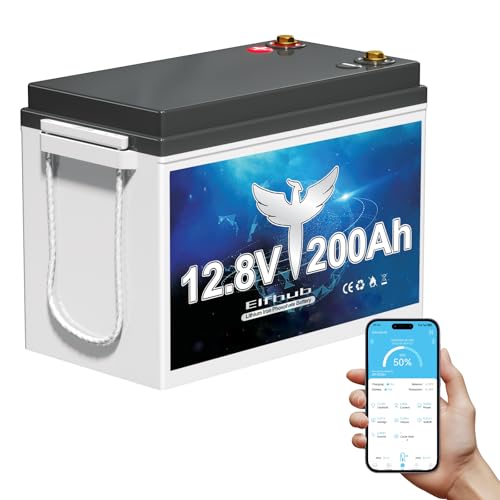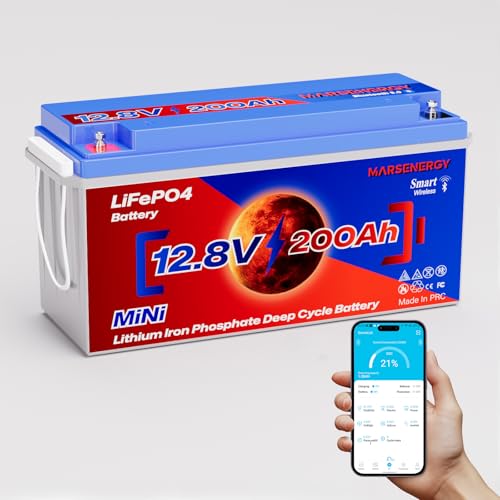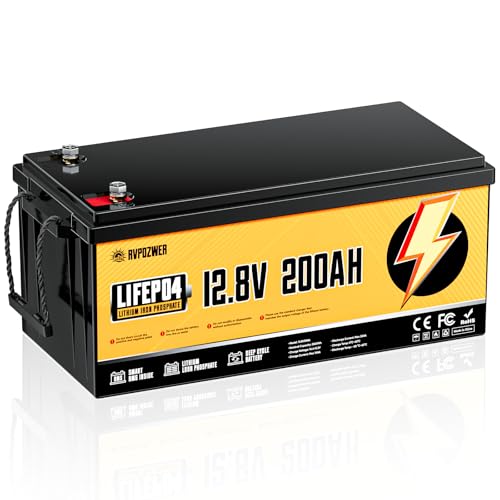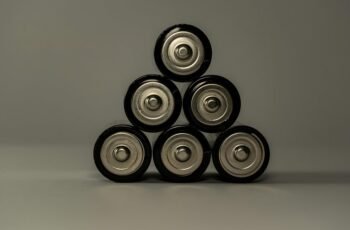If we’re shopping for dependable off-grid or RV power this year, 200Ah LiFePO4 batteries stand out for cycle life, stable output, and smart BMS features. We’ve compared top models that handle high current, offer Bluetooth monitoring, and scale from 12V to 48V. We’ll weigh real-world capacity, cold-weather protection, footprint, and value—so we can match a battery to our rig, solar array, and budget. Let’s start with what actually performed under load…
Key Takeaways
- Prioritize 12V 200Ah LiFePO4 with smart 200A BMS, cold-charge cutoff, and Bluetooth for safe, high-output RV/off-grid performance.
- Look for expandable designs supporting up to 4S/4P (48–80V) for system growth and flexible parallel capacity.
- Choose models with proven cycle life: 4,000+ cycles at 100% DoD, 8,000–15,000 at moderate DoD for long-term value.
- Verify operating and charging temps; BMS should block charging below 32°F and manage heat to preserve lifespan.
- Consider weight and size; typical 41–57 lb units fit RV compartments, balancing energy density with installation ease.
12V 200Ah MINI LiFePO4 Bluetooth Lithium Battery with 200A BMS for RV, Solar, Trolling Motors
November 19, 2025 10:21 am
Need a compact 12V powerhouse you can actually monitor in real time? We like this 12V 200Ah MINI LiFePO4 with Bluetooth and a 200A BMS. It delivers 2560Wh per battery, with series/parallel options up to 51.2V and 800Ah (40.96kWh, 40.96kW max). The app shows current, voltage, cell balance, temps, cycles, and load/charge history—plus estimated time remaining. Safety’s covered: LiFePO4 chemistry, UL-certified cells, low-temp cut-off, no acid, mount in any position. Expect up to 15,000 cycles and >80% capacity after 2,000. It’s ideal for RVs, solar, and trolling motors, with a five-year warranty and responsive support.
Best For: RV owners, off-grid solar users, and boaters who want a compact 12V LiFePO4 battery with high current capability and real-time Bluetooth monitoring.
Pros:
- 2560Wh per battery; scalable up to 51.2V/800Ah (40.96kWh, 40.96kW max) for large systems
- Bluetooth app shows live current/voltage, cell balance, temps, cycles, history, and time remaining
- 200A BMS, LiFePO4 chemistry, low-temp cut-off, UL-certified cells; mount in any position; 5-year warranty
Cons:
- No dedicated Bluetooth on/off switch noted by some users (potential security/privacy concern)
- App experience may vary; some users prefer third-party BMS apps
- Initial setup/packaging quirks reported; maximum performance requires correct series/parallel configuration
NPP 12V 200Ah Gel Deep Cycle Battery (NPG12-200Ah)
November 19, 2025 12:27 pm
Looking for a rugged, maintenance-light alternative to LiFePO4 for harsh climates? The NPP NPG12-200Ah is a 12V, 200Ah gel VRLA deep-cycle workhorse that thrives from -40°C to 60°C. It’s spill-proof, mounts in any position, shrugs off vibration, and delivers smooth voltage with a mild discharge curve.
We like its <3% self-discharge and up to 1200+ cycles. Storage is easy—can sit nearly two years electrified. Specs: 20.55 x 9.37 x 8.58 inches, about 137.8 lbs, UL/CE/IEC certified, with a 100-day money-back guarantee. Trade-offs: it’s heavy, some users report longevity inconsistencies and heat/bulging in isolated cases. Size inverters/wiring correctly for high loads.
Best For: Off-grid, RV, marine, and cabin users in harsh climates who want a rugged, maintenance-light 12V deep-cycle battery with long storage life and broad operating temps as an alternative to LiFePO4.
Pros:
- Wide operating range (-40°C to 60°C), spill-proof VRLA gel design; mounts in any position and resists shock/vibration
- Low self-discharge (<3%) and can be stored nearly two years electrified; 1200+ cycle lifespan
- Certified (UL/CE/IEC) with smooth voltage delivery and a 100-day money-back guarantee
Cons:
- Very heavy at ~137.8 lbs; bulky for transport/installation
- Mixed user reports on long-term longevity; isolated cases of heat/bulging or early failure
- Requires correct inverter sizing and heavy-gauge wiring for high loads; lower energy density than LiFePO4
12V 200Ah LiFePO4 Battery with 200A BMS for RV, Solar, and Off-Grid
November 20, 2025 12:23 am
Serious boondockers and solar DIYers will appreciate this 12V 200Ah LiFePO4 pack’s built‑in 200A BMS and 2,560W max output, giving headroom for high‑draw inverters and RV appliances without voltage sag. We like the automotive‑grade cells, flat 12.8V discharge curve, and 95% efficiency, which let you use about 95% of capacity. At 41.8 lb and 2,560Wh, it delivers 51.61 Wh/lb—about 11% higher energy density than many peers and far better than lead‑acid. The BMS covers over/under‑voltage, overcurrent, short circuit, and temp protection with a 32°F low‑temp charge cutoff. It’s IP65 rated, FCC/UL certified, and rated 4,000+ cycles, 10‑year life.
Best For: RV owners, off-grid cabins, and solar DIYers who need a lightweight, high-output 12V battery with robust protections and long cycle life for running inverters and appliances.
Pros:
- 200A BMS and 2,560W max output handle high-draw inverters/appliances with minimal voltage sag
- High energy density (51.61 Wh/lb) at only 41.8 lb; ~95% usable capacity with flat 12.8V curve
- 4,000+ cycles, 10-year lifespan; IP65, FCC/UL certifications, and comprehensive protections
Cons:
- Low-temp charge cutoff at 32°F requires heating solution for winter charging
- Higher upfront cost than lead-acid alternatives
- User feedback mixed on charge retention over time depending on use and setup
12V 200Ah LiFePO4 Lithium Battery with Built-in 200A BMS for RV, Solar, and Marine
November 19, 2025 10:21 am
For RVers, boaters, and off‑grid users who want high current headroom without extra weight, this 12V 200Ah LiFePO4 from Elfhub pairs a stout 200A BMS with a 2560Wh capacity in a 42 lb, IP65-rated case. We get up to 2560W continuous load, Bluetooth app monitoring for SOC, voltage, current, and temperature protections: no charging below 32°F and cutoff at 158°F. Expect 4000+ cycles at 100% DOD (6000 @ 80%, 15,000 @ 60%). It’s CE/RoHS certified, supports series/parallel, and fits compact installs (13.58 x 7.48 x 9.64 inches). Warranty is 5 years, with responsive support. Note: some courier/return issues reported.
Best For: RVers, boaters, and off‑grid users who need high current headroom, long cycle life, and app monitoring in a compact, lightweight 12V battery.
Pros:
- 200A BMS supports up to 2560W continuous load with robust protections (over/under voltage, overcurrent, short circuit, temp)
- Long lifespan: 4000+ cycles @100% DOD (6000 @80%, 15,000 @60%); lighter and higher energy density than lead-acid
- IP65 waterproof, compact 42 lb form factor with Bluetooth app for real-time SOC, voltage, and current
Cons:
- Cannot charge below 32°F (0°C); high-temp cutoff at 158°F may limit extreme environments
- Requires appropriate LiFePO4-compatible charger; reported charger noise variability
- Mixed customer service/courier return experiences noted despite 5-year warranty
LiFePO4 12V 200Ah Lithium Battery with 200A BMS for RV, Marine, Solar, and Off-Grid
November 19, 2025 10:21 am
Need a 12V, 200Ah workhorse that’s safe, scalable, and road‑ready? This LiFePO4 battery delivers 2560Wh in a compact 20.6 x 9.5 x 8.5 form at just 51.81 lbs. We get 4000–15000 deep cycles with stable voltage—far outlasting lead‑acid. The integrated 200A BMS protects against overcharge, over‑discharge, over‑current, short‑circuit, and high temps, operating from -20°C to 60°C and meeting SDS/UN38.3/CE.
Scale in parallel or series to 800Ah or 48V (51.2V). Before series, balance with a dedicated 12V (14.6V), 20A LiFePO4 charger. If deep discharge locks the BMS, recover by charging ~5 minutes. Ideal for RVs, marine, solar, off‑grid, trolling motors, golf carts, and backup.
Best For: RV owners, boaters, and off‑grid/solar users who need a lightweight, long‑life 12V power source that’s safe, scalable, and easy to install.
Pros:
- Long lifespan with 4000–15000 deep cycles and stable voltage, outlasting lead‑acid
- Integrated 200A BMS with full protections and compliance (SDS/UN38.3/CE)
- Scalable to 48V or 800Ah; compact 51.81 lbs design for easier handling and installation
Cons:
- Requires a dedicated 12V (14.6V), 20A LiFePO4 charger for proper balancing before series use
- BMS can lock after deep discharge and may need a ~5‑minute recharge to reactivate
- Higher upfront cost versus lead‑acid (though lower total cost over lifespan)
12V 200Ah LiFePO4 Battery with Bluetooth and 200A BMS
November 19, 2025 10:21 am
Looking for a rugged, smart 12V powerhouse with real-world stamina? We like the Marsenergy LFP12200 (12.8V 200Ah) with Bluetooth and a built-in 200A BMS. It often delivers over 210Ah, weighs just 42 pounds, and measures 19.02 x 9.45 x 6.69 inches. Expect serious longevity: 4,500 cycles at 100% DOD, 8,000 at 80%, and 15,000 at 60%. The A-grade cells handle -40°F to 162°F, plus immersion, vibration, and 3-foot drops.
The smart BMS guards against shorts, over-voltage, and abnormal temps, then sleeps safely. Scale to 4S4P (up to 51.2V/800Ah, 40.96 kWh). Ideal for RVs, marine, solar, and home backup. Five-year support.
Best For: RVers, boaters, and off-grid homeowners who want a rugged, Bluetooth-enabled 12V LiFePO4 with long cycle life, high current (200A BMS), and scalable capacity for solar, trolling motors, and home backup.
Pros:
- Long lifespan: up to 4,500 cycles at 100% DOD (8,000 at 80%, 15,000 at 60%)
- Lightweight and compact for 200Ah (42 lb; 19.02 x 9.45 x 6.69 in), often delivers >210Ah
- Robust BMS with Bluetooth monitoring; supports up to 4S4P (51.2V/800Ah, 40.96 kWh)
Cons:
- Requires following wake/sleep procedures after BMS protection trips
- Operating temperature range is broad, but charging in extreme cold/heat may still be limited by BMS
- Higher upfront cost than lead-acid; charger/inverter compatibility checks needed for LiFePO4 settings
12V 330Ah LiFePO4 Lithium Battery with 200A BMS (4224Wh)
November 19, 2025 10:21 am
Serious off‑grid builders who want a compact heavyweight will appreciate the V 12V 330Ah LiFePO4 with a 200A BMS and 4224Wh of energy. We get up to 10,000+ cycles, Grade A cells, and a smart BMS guarding against over‑charge, over‑discharge, over‑current, and short circuits. At 56 pounds and 7.64 x 13.74 x 9.84 inches, it’s small for its class. It supports series/parallel up to 80V, so 24V–72V banks are straightforward. Expect low self‑discharge and cold‑charge cutoff at 32°F. Some versions add a top display or Bluetooth—verify UI language. Users report ~299.5Ah delivered and strong value versus pricier brands.
Best For: Off‑grid builders, RV/van owners, and solar storage users who need a compact, high‑capacity 12V LiFePO4 battery with robust 200A BMS protection and long cycle life.
Pros:
- High usable capacity (330Ah/4224Wh) with Grade A cells and up to 10,000+ cycles for long service life
- 200A smart BMS with protections (over‑charge/discharge, over‑current, short‑circuit) and cold‑charge cutoff
- Compact and relatively light for its class (56 lb; 7.64 x 13.74 x 9.84 in), supports series/parallel up to 80V
Cons:
- Some user tests report delivered capacity around ~299.5Ah, below the 330Ah claim
- Bluetooth/display features vary by model; UI language may be limited on some versions
- Charging disabled below 32°F (0°C), requiring temperature management in cold environments
GOLDENMATE 12V 200Ah LiFePO4 Lithium Battery with Built-in BMS
November 19, 2025 12:27 pm
For off-grid cabins and RVs that demand long runtime without fuss, the GOLDENMATE 12V 200Ah LiFePO4 stands out with 2,560Wh of usable energy, a robust built-in BMS, and up to 15,000+ cycles. We like its 12.8V nominal output, low self-discharge, and 120A continuous discharge for heavier loads. It supports up to 100A charging via LiFePO4 chargers, solar MPPT, or generators. The BMS covers overcharge, over-discharge, over-current, overheating, short-circuit, plus high/low-temp protection. At 57.3 lb (8.58 x 20.55 x 9.44 in), it’s compact, maintenance-free, and expandable to 51.2V 800Ah (4S/4P). Note: not a starter battery; monitor cell balance.
Best For: Off-grid cabins, RVs, and marine users needing long runtime, high cycle life, and maintenance-free 12V power with expandable capacity.
Pros:
- 2,560Wh capacity with 120A continuous discharge handles heavier loads; up to 100A fast charging via LiFePO4 chargers, solar MPPT, or generators
- Long lifespan (15,000+ cycles), low self-discharge, and no memory effect; maintenance-free design
- Robust built-in BMS with overcharge, over-discharge, over-current, overheating, short-circuit, and high/low temperature protection; expandable up to 51.2V 800Ah (4S/4P)
Cons:
- Not suitable as a starter battery for engines
- Heavier than smaller-capacity LiFePO4 units at 57.3 lb and sizable dimensions
- Users should monitor cell balance; state-of-charge readings can vary by external monitors
12V 200Ah LiFePO4 Battery with 200A BMS for Solar, RV, and Off-Grid Systems
November 19, 2025 10:21 am
Need a 12V 200Ah pack that can actually deliver high current for RVs and off‑grid loads? We like this 12V 200Ah LiFePO4 with a robust 200A smart BMS. It provides 2560Wh, supports 850W inverters in user tests, and handles series (up to 51.2V) or parallel (up to 800Ah). Grade‑A cells, long lifespan (4000 cycles at 100% DOD; up to 15,000 at 60%), and an operating range of -20°C to 65°C make it versatile.
At 45.2 lb and Group 31 dimensions, it’s lighter than lead‑acid and easy to handle. Note mixed reports on shipping voltage and charging quirks. Warranty, lifetime tech support, and Amazon returns help.
Best For: RV owners, off‑grid users, and solar setups needing a lightweight 12V 200Ah LiFePO4 battery with high current delivery, long cycle life, and flexible series/parallel expansion.
Pros:
- 200A smart BMS enables high current output; user tests show reliable 850W inverter support
- Long lifespan: 4000 cycles at 100% DOD; up to 15,000 at 60% DOD; Grade‑A LiFePO4 cells
- Versatile and portable: Group 31 size, 45.2 lb, operates from -20°C to 65°C; series up to 51.2V or parallel to 800Ah
Cons:
- Mixed reports of units arriving with low voltage or early failure
- Some users note charging behavior quirks depending on chargers/settings
- Heavier upfront cost vs. lead‑acid despite longer life savings
LOSSIGY 24V 200Ah LiFePO4 Lithium Battery with 200A BMS (5.12kWh)
November 19, 2025 10:21 am
Built around a robust 200A BMS and 5.12kWh of usable energy, the LOSSIGY 24V 200Ah LiFePO4 stands out for RVers and off‑grid users who want high discharge capability without a bulky multi-battery setup. We like its auto grade‑A cells, at least 4,000 cycles, and comprehensive protections for temp, short circuit, over‑current, and overload. At 86.9 pounds with compact dimensions, installation’s straightforward, and series/parallel flexibility lets us scale to 48V banks.
In use, it runs inverters for heaters and coffee makers, holds voltage well, and handles cold to about 27°F. Pair it with a DC‑DC or MPPT charger. Warranty’s limited; support responsiveness rates well.
Best For: RVers, boaters, and off‑grid users who need a high‑capacity 24V LiFePO4 battery with strong 200A discharge, compact size, and easy scaling to larger banks.
Pros:
- 5.12kWh capacity with 200A BMS supports high-draw inverters and appliances
- Grade A LiFePO4 cells with ≥4,000 cycles and comprehensive BMS protections
- Lighter and simpler than multi‑battery lead‑acid setups; flexible series/parallel expansion up to 48V
Cons:
- Limited warranty (90‑day after‑sales) compared to some competitors
- Charging performance drops below 32°F; may need insulation or heating in cold climates
- Heavier than smaller-capacity LiFePO4 packs (86.9 lb) and uses stud terminals requiring proper hardware
Factors to Consider When Choosing 200AH Lifepo4 Batteries
Before we pick a 200Ah LiFePO4 battery, we’ll check the chemistry type and cycle life rating to guarantee long-term reliability. We’ll look for robust BMS protections and solid temperature tolerance so the pack stays safe and performs in heat or cold. We’ll also weigh the trade-offs in weight and size to match your space and portability needs.
Battery Chemistry Type
Why does chemistry matter so much when we’re choosing a 200Ah battery? Because LiFePO4 defines how the pack performs, weighs, and stays safe in our rigs. A 200Ah LiFePO4 typically delivers about 2,560Wh at a nominal 12.8V, giving us steady voltage thanks to its flat discharge curve. That stability helps sensitive RV electronics and inverters run predictably.
Weight is practical too—most 200Ah LiFePO4 packs land around 40–60 lbs, far lighter than equivalent lead-acid setups. Safety’s built in: quality packs include a BMS to guard against overcharge, over-discharge, over-current, and short circuits. We do need to respect temperature limits; many units restrict charging near 32°F (0°C) and operate roughly from -20°C to 65°C. Choose chemistry—and BMS features—that fit your climate and gear.
Cycle Life Rating
So, how long will a 200Ah LiFePO4 actually last in daily use? We look at the cycle life rating. Most quality 200Ah packs advertise 4,000–15,000 cycles, and the spread comes down to depth of discharge (DOD). If we routinely drain to 100% DOD, expect around 4,000+ cycles. If we keep daily use to roughly 60–80% DOD, cycle counts climb dramatically—often 8,000–15,000 cycles.
Manufacturers also pair cycle counts with lifetime claims (often up to 10 years). That’s because longevity isn’t just cycles; calendar life matters too. Real-world results depend on temperature, charging profile, and how evenly cells stay balanced. For most off-grid and RV users cycling once per day at moderate DOD, we can plan for many years of reliable service with minimal capacity fade.
BMS Protections
Curious what actually keeps a big 200Ah LiFePO4 safe and reliable day after day? It’s the battery management system. A robust 200A BMS guards against overcharge, over-discharge, over-current, short-circuit, and overheating so the pack stays protected during heavy charging and high-load discharging. We also like BMS units with automatic cell balancing to keep voltages equal across 4S configurations, preserving capacity and minimizing drift over time.
Good BMS designs manage temperature, cutting charge or output at defined high/low thresholds to prevent cell damage. If a deep discharge trips protection, some packs enter a lock or sleep mode—be ready to reactivate with a proper 12V charger. Finally, verify the BMS supports your wiring plans; many allow series and parallel banks within stated limits.
Temperature Tolerance
How does temperature swing affect a 200Ah LiFePO4 in the real world? It impacts capacity, charging, and longevity. Most packs operate safely from about -20°C to 65°C (-4°F to 149°F), but charging is the tight spot. We should look for a specified charging window—commonly 0°C to 45°C (32°F to 113°F)—because many BMSs cut off charging at freezing to protect cells.
Cold reduces available discharge capacity and efficiency; heat accelerates degradation and shortens cycle life. That’s why onboard temperature sensors and automatic BMS protections matter—they’ll limit charging or even discharging when temps go out of bounds.
For best service life, we keep the battery within the manufacturer’s recommended range, avoid prolonged freezing, and prevent sustained high heat, especially during charging.
Weight and Size
Keeping temps in check is only half the story—we also need a battery that physically fits and doesn’t overload our rig. Most 200Ah LiFePO4 units land between 41 and 57 pounds, a big weight win over comparable lead-acid. That matters for payload limits, tongue weight, and ease of installation—we can often lift one without a second person.
Size varies by enclosure. Expect roughly 13–22 inches long, 7–10 inches wide, and 6–10 inches tall. Measure the compartment, add room for cables and ventilation, and confirm orientation requirements. Higher energy-density designs shave pounds without sacrificing capacity, which helps in tight or weight-sensitive builds.
Some batteries use rackable or modular cases, tightening footprints in cabinets or bays and simplifying neat, scalable installations later.
Series/Parallel Options
For most builds, deciding between series and parallel connections sets the tone for performance, safety, and upgrade flexibility. We use series to raise system voltage—four 12.8V LiFePO4 batteries in series (4S) land us near 51.2V—while keeping the same 200Ah per string. Parallel adds capacity at roughly the same voltage; two in parallel doubles to 400Ah, and up to 4P can reach 800Ah. A common ceiling is 4S4P, delivering about 51.2V and 800Ah for larger inverters and longer runtimes.
Higher-series stacks demand a charger and BMS rated for the increased pack voltage, so we confirm specs before wiring. When combining batteries, we match capacity, chemistry, and state of charge, then balance before connecting to ensure even currents, stable voltages, and long-term safety.
Warranty and Support
After we map out series and parallel plans, the safety net comes from warranty and support. We look for multi-year coverage—five years is common—but we read the fine print on defects, labor, and replacement conditions. Strong after-sales support matters, too. Brands that offer technical assistance, troubleshooting, and 24/7 or next‑business‑day responses save us time when issues arise.
We also check return windows. Policies typically span 30 to 100 days; some include money‑back guarantees or refurbished/replacement options for defective units. To keep warranties valid, we follow specified charge voltages, temperature limits, and mounting guidelines.
Finally, app-based monitoring and BMS data access help diagnostics and claims. When we can pull logs, we resolve problems faster and protect battery health—and our investment.
Conclusion
We’ve explored the best 200Ah LiFePO4 batteries of 2025, highlighting strong BMS protection, reliable cycle life, and flexible expansion from 12V to 51.2V systems. Whether we’re powering RVs, off-grid cabins, or marine setups, these picks balance safety, capacity, and smart monitoring. Let’s match our loads, charging specs, and temperature needs to the right battery, then plan for series/parallel growth. Choose wisely, wire cleanly, protect against cold, and we’ll enjoy dependable, long-lasting power wherever we roam.












